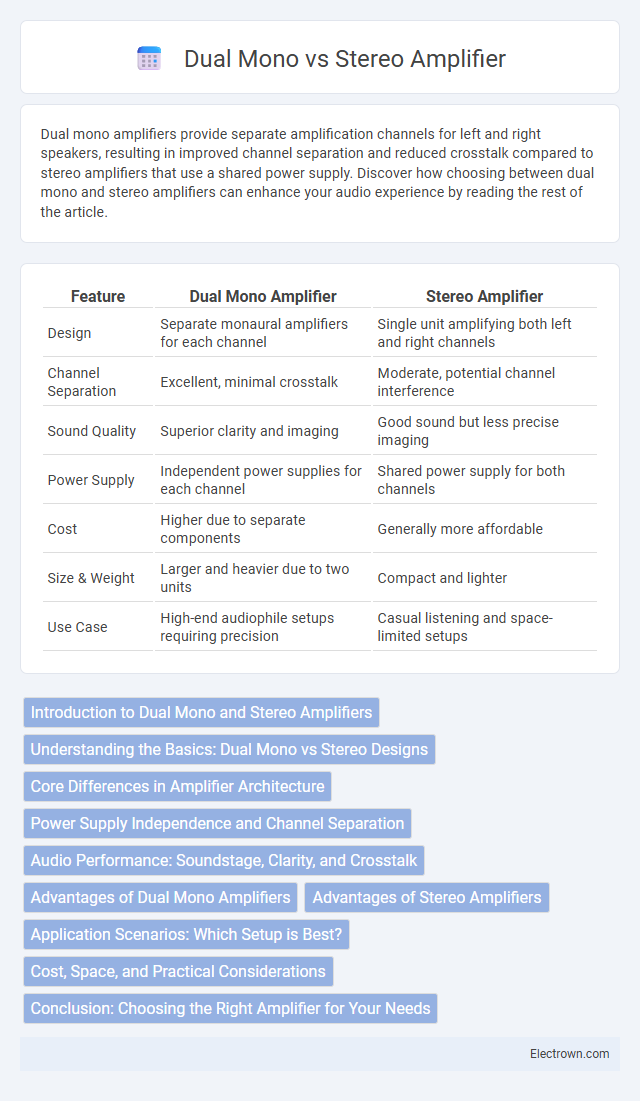Dual mono amplifiers provide separate amplification channels for left and right speakers, resulting in improved channel separation and reduced crosstalk compared to stereo amplifiers that use a shared power supply. Discover how choosing between dual mono and stereo amplifiers can enhance your audio experience by reading the rest of the article.
Table of Comparison
| Feature | Dual Mono Amplifier | Stereo Amplifier |
|---|---|---|
| Design | Separate monaural amplifiers for each channel | Single unit amplifying both left and right channels |
| Channel Separation | Excellent, minimal crosstalk | Moderate, potential channel interference |
| Sound Quality | Superior clarity and imaging | Good sound but less precise imaging |
| Power Supply | Independent power supplies for each channel | Shared power supply for both channels |
| Cost | Higher due to separate components | Generally more affordable |
| Size & Weight | Larger and heavier due to two units | Compact and lighter |
| Use Case | High-end audiophile setups requiring precision | Casual listening and space-limited setups |
Introduction to Dual Mono and Stereo Amplifiers
Dual mono amplifiers feature two completely independent amplification channels, each with its own power supply and circuitry, providing superior channel separation and reduced crosstalk compared to stereo amplifiers, which share internal components for both channels. This structural difference allows dual mono designs to deliver clearer, more precise audio reproduction ideal for audiophiles seeking high-fidelity sound performance. Stereo amplifiers, while generally more cost-effective and space-efficient, may compromise on channel isolation and overall sound purity due to shared internal pathways.
Understanding the Basics: Dual Mono vs Stereo Designs
Dual mono amplifiers feature two completely separate channels with independent power supplies and circuitry, reducing crosstalk and enhancing channel separation for improved sound clarity. Stereo amplifiers share components for both channels, which can introduce minor interference but typically offer a more compact and cost-effective design. Your choice depends on whether you prioritize audio purity and isolation (dual mono) or convenience and budget (stereo).
Core Differences in Amplifier Architecture
Dual mono amplifiers feature two completely independent amplification circuits, each with separate power supplies and components for the left and right channels, minimizing crosstalk and interference. Stereo amplifiers use a single shared power supply and circuit board to amplify both channels, which can introduce slight channel interaction and noise. The isolated architecture of dual mono designs leads to improved channel separation, dynamic range, and overall sound clarity compared to conventional stereo amplifiers.
Power Supply Independence and Channel Separation
Dual mono amplifiers feature completely independent power supplies for each channel, significantly reducing crosstalk and interference, which enhances channel separation. This design ensures that each channel receives clean, stable power, minimizing noise and distortion for a more precise and immersive audio experience. Your listening experience benefits from clearer separation of instruments and vocals compared to typical stereo amplifiers with shared power supplies.
Audio Performance: Soundstage, Clarity, and Crosstalk
Dual mono amplifiers deliver superior audio performance by providing completely separate power supplies and circuitry for each channel, significantly enhancing soundstage depth and clarity. This separation reduces crosstalk to near zero, preserving channel independence and spatial imaging accuracy. In contrast, stereo amplifiers often exhibit higher crosstalk levels, which can blur soundstage details and diminish overall audio fidelity.
Advantages of Dual Mono Amplifiers
Dual mono amplifiers offer superior channel separation, reducing crosstalk and providing a clearer, more precise soundstage. Each channel operates with its own dedicated power supply, minimizing interference and enhancing dynamic range and detail resolution. Your audio system benefits from improved imaging and a more immersive listening experience compared to traditional stereo amplifiers.
Advantages of Stereo Amplifiers
Stereo amplifiers provide a unified design that simplifies installation and reduces overall system complexity, making them ideal for home audio setups. They offer cost-effective performance with a single chassis powering both left and right channels, ensuring balanced sound reproduction. Your listening experience benefits from consistent audio quality and easier integration with consumer electronics.
Application Scenarios: Which Setup is Best?
Dual mono amplifiers excel in high-end audio setups where channel separation and minimal crosstalk are critical, such as audiophile listening rooms or professional studios. Stereo amplifiers are ideal for everyday home audio systems and casual listening environments, offering a practical balance of performance and cost. Selecting the best setup depends on the priority of sound fidelity versus budget and space constraints.
Cost, Space, and Practical Considerations
Dual mono amplifiers typically cost more than stereo amplifiers due to their duplicated components, which also require more physical space in an audio setup. Stereo amplifiers combine both channels in a single chassis, making them more space-efficient and often easier to integrate into existing systems. Practical considerations favor stereo amplifiers for general use, while dual mono designs appeal to audiophiles seeking improved channel separation and reduced crosstalk despite higher expense and larger footprint.
Conclusion: Choosing the Right Amplifier for Your Needs
Dual mono amplifiers deliver superior channel separation and reduced crosstalk, making them ideal for audiophiles seeking precise soundstage and clarity. Stereo amplifiers offer convenience and space-saving design, suitable for typical home audio setups without compromising overall audio quality. Your choice depends on whether you prioritize high-fidelity performance or practical integration within your audio system.
dual mono vs stereo amplifier Infographic

 electrown.com
electrown.com